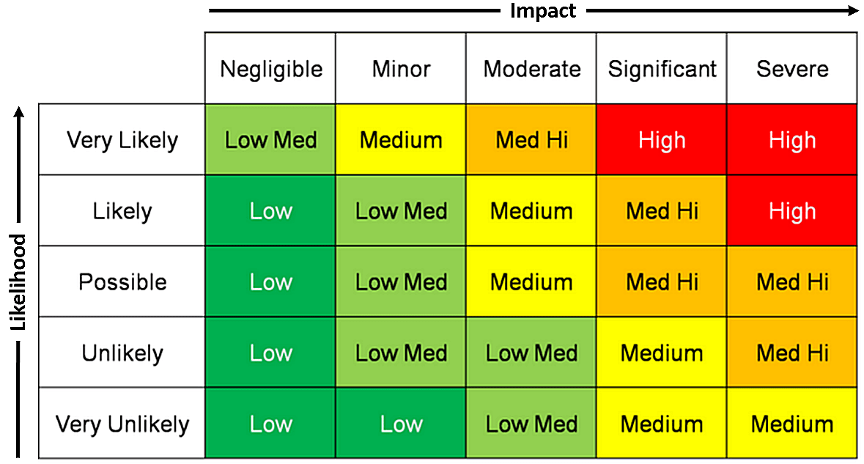As school administrators grapple with the challenges presented by the COVID-19 pandemic, they are realizing, more than ever before, the importance of risk assessment in schools. The stakes are high, so understanding risk management and developing a risk management plan for your school is critical.
Below, we will go over the key concepts of risk management in schools.
What Is Risk Management?
We all manage risk in our daily lives. When we cross the street, order food (let’s say a fried oreo), or call an old friend, we are analyzing the pros and cons of each action, along with associated risks. Will I make it across the street in time? Will the fried food catch up to me? Is my old friend going to be the same as they were in the past?
During this deliberation process, our mental lives are uncontrolled, populated with hundreds of reasons supporting and rebuking each possible action. While this chaotic approach to risk management works for most of us in our daily wanderings, a more controlled approach must be taken when assessing and reducing risks in our schools.
Risk management is the process of making and taking action on decisions that will minimize the adverse effects of risk on an organization.In schools, possible risks include injury of a student, a lawsuit filed by an angry parent, or damage to the school's reputation.
While a lawsuit sounds scary as a school administrator, it is best to focus on preventing the first example: any harm or danger to a student.This focus will give you the motivation needed to follow through with your risk management strategy since it's a person at risk, not the organization's finances. This motivation is key, especially when risk management is a process that lasts all year.
Why Is Risk Management Important in Schools?
Risk management is important because it keeps your students, faculty, and finances safe from any harm, while also protecting your financial assets and lowering your legal liability. Not only will developing a risk management plan for your school reduce the chances of risks, but it will also mitigate the effects of those risks if they should occur.
For example, if you do have a student that is showing symptoms from COVID-19 during the school day, you will already have a response plan in place to make sure the adverse effects stop there. You'll be able to prevent the spread.
Risk management comes with these benefits for school administrators:
- Protect people from harm.
- Limit the possibility of a lawsuit.
- Safeguard your public reputation.
- Reduce potential losses in revenue.
- Make your students, teachers, and parents feel safe.
Risk is prevalent in any mission, from exploring outer space to educating our children. The goal is not to eliminate all possible risks (that's impossible and would lead to a pretty boring life). The goal is to manage the risks appropriately. Here, we will show you how to do so, by creating a risk management plan for your school.
How to Create a Risk Management Plan for Your School
1) Identify Risks
Before you can develop response plans, you need to know which risks are out there. Some will be obvious, such as a COVID-19 infection, while others will be more hidden, such as an unsafe part of the playground.
To track down every risk, brainstorm with your team. Also, include other stakeholders and industry experts in your identification process. They might have experience which sheds light on risks your team hadn't thought about.
Once you have found all the risks, put them in a centralized location, accessible to your entire team. That way, your team can continuously monitor the risks. It also helps to divide your risks up into categories. For example, you could have a section for operational risks and one for financial risks. Or, you could separate them by parts of the school-day, by creating categories like recess risks or cafeteria risks.
2) Assess Each Risk's Likelihood and Impact
Once you have the list of risks, you can start analyzing each one.Start by going through the list and giving them a likelihood score (low to high). Then, give them an impact score (low, moderate, or severe).

Image Source: Risk Academy
You can also assign probabilities or numbers to each riskYou can use these numbers in this formula to calculate each event's risk.
Risk = Probability x Impact.
Then, put the organized matrix of risks into a live document where your team members can track and update them. For instance, if one child became sick from a certain contagious skin infection, then the probability, and therefore risk, of the event would increase.
3) Create Response Plans
Next, you should create plans to lessen the chances of risks occurring and responses if the risks should occur. A plan to lessen the chances of risk of infection on a school bus could be limiting bus capacity. And, a response would be what actions to take if a child shows symptoms on the bus.
Remember, the magnitude of loss prevention measures taken in schools for each risk depends on the risk's probability and severity. So, when creating response plans, you need to keep your resources (time, budget) in mind. It's unwise to spend a lot of a teacher's time on preventing a low probability, low impact risk, like a student losing their favorite pencil.
4) Choose a Lead for Each Risk
In the book, "Influence", Robert Cialdini writes about how social psychology influences our actions.
In one passage, he shares advice that could be life-saving. If you were to ever feel a stroke coming on while in a large group (a concert, train station, etc.) you should point to someone and say, "You, yes, you in the green shirt. Call 911. I'm in trouble and need help."
Why so forward? Well, when you pick a leader, you assign them responsibility, and the selected person is, therefore, more likely to take immediate action. On the other hand, if you were to just sit there and yell for help, the response would lag. Every person, no matter how kind or caring, would pause and look at everyone else, wondering who is most qualified or equipped to help.
So, for each response to each risk, you need to select a leader.That way, if the event should take place, there will be no confusion on who needs to begin the response plan. The leader will put water on the fire as quickly as possible.
5) Make Contingency Plans
Because life seems to love testing us, even risk responses have associated risks. Sometimes the first response plan will go wrong because you lack the right resources at the time. Or, perhaps the circumstances are slightly different than your team had anticipated. For example, sometimes afire renders one escape route unusable. You need another safe way out.
So that these possible problems don't completely derail your response efforts, you need contingency plans (plan Bs) for each risk, especially the most likely and severe ones. Make sure to put these in your centralized location also, and ensure the owner of the risk is aware of the plan B.
6) Continuously Monitor Risks
New risks will come into play as the school year progresses, especially during such unprecedented times, So, it's critical to monitor your risks and continue adding new ones or editing the probabilities of old ones.This is where a management system designed for running schools comes in handy.
Best Practices for Managing Risk This School Year
Since the biggest aspect of risk management this school year is controlling the spread of COVID-19, here are some steps schools are taking to manage it.
1) Limit Bus Capacity
"The best option for children getting to school would be for their parents to drop them off," says Dr. Tina Tan, Northwestern University pediatrics infectious disease specialist.
Of course, this isn't an option for every parent, but the more who can make the sacrifice the better. Along with a limited bus capacity, disease experts, such as
Dr. Judith Guzman-Cottrill, say to keep the bus windows open if possible.
2) Enforce Entry Guidelines
It's important to keep infected individuals out of the school so that they don't infect others. Powering through illness used to be a trait of the strong in our society. However, we need to change this idea and stay home if we feel the slightest touch of illness.
K-12 administrators should make clear policies on when students and teachers must stay home. They also need to create response plans in case a few teachers are out for a prolonged period of time.
3) Have a Plan Ready for if Someone is Sick
If a child or teacher starts to show symptoms in the classroom, you need to have a clear plan on what to do next. This should be one of your highest priority risks to plan for since both the possibility and severity are rather high in this climate.
4) Clean and Disinfect Regularly
High touch surfaces need to be cleaned regularly, according to CDC guidelines.So, get together with your team and assess which surfaces these are in the school. These are usually doorknobs, bathroom doors, and sink areas.
5) Stagger Cafeteria Times
Eating lunch requires removing face masks, so social distancing is extra crucial here.
6) Move Your Work Online
Of course, not everything can be done online, but certain tasks can be. Identify what needs to be done in person and what doesn’t. For example, parents don’t need to come into the schools for an update; you can send messages to them via text or email. Or, rather than passing paper from schools to students to parents and back, do it digitally.
You Don't Have to Do it Alone
It can be a complex process enacting a risk management initiative in your school. Even after your risk assessment, there is a lot to keep track of.You have to continuously update and report on risks. Plus, you must give every administrator transparency into how the risk management strategy is working.
There are tools you can use to help and plenty of resources. Risk management is an ongoing process, and it has to be collaborative to succeed.Don’t worry about doing it all at once; get together with your team, make a plan, and track your progress. As school administrators grapple with the challenges presented by the COVID-19 pandemic, they are realizing, more than ever before, the importance of risk assessment in schools. The stakes are high, so understanding risk management and developing a risk management plan for your school is critical.
Our Education Specialist are standing by to support you and your organization. Schedule time with us today to learn more! 








